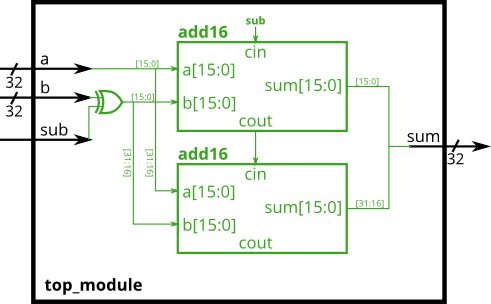Module addsub
Problem Statement
An adder-subtractor can be built from an adder by optionally negating one of the inputs, which is equivalent to inverting the input then adding 1. The net result is a circuit that can do two operations: (a + b + 0) and (a + ~b + 1). See Wikipedia if you want a more detailed explanation of how this circuit works.
Build the adder-subtractor below.
You are provided with a 16-bit adder module, which you need to instantiate twice:
module add16 ( input[15:0] **a**, input[15:0] **b**, input **cin**, output[15:0] **sum**, output **cout** );
Use a 32-bit wide XOR gate to invert the b input whenever sub is 1. (This can also be viewed as b[31:0] XORed with sub replicated 32 times. See replication operator.). Also connect the sub input to the carry-in of the adder.
Tip
An XOR gate can also be viewed as a programmable inverter, where one input controls whether the other should be inverted. The following two circuits are both XOR gates: 
My Solution
module top_module(
input [31:0] a,
input [31:0] b,
input sub,
output [31:0] sum
);
reg [15:0] sum1;
reg [15:0] sum2;
wire cout1;
add16 u_add16_a (
.a(a[15:0]),
.b({16{sub}} ^ b[15:0]),
.cin(sub),
.sum(sum1),
.cout(cout1)
);
add16 u_add16_b (
.a(a[31:16]),
.b({16{sub}} ^ b[31:16]),
.cin(cout1),
.sum(sum2),
.cout()
);
assign sum = {sum2, sum1};
endmodule
